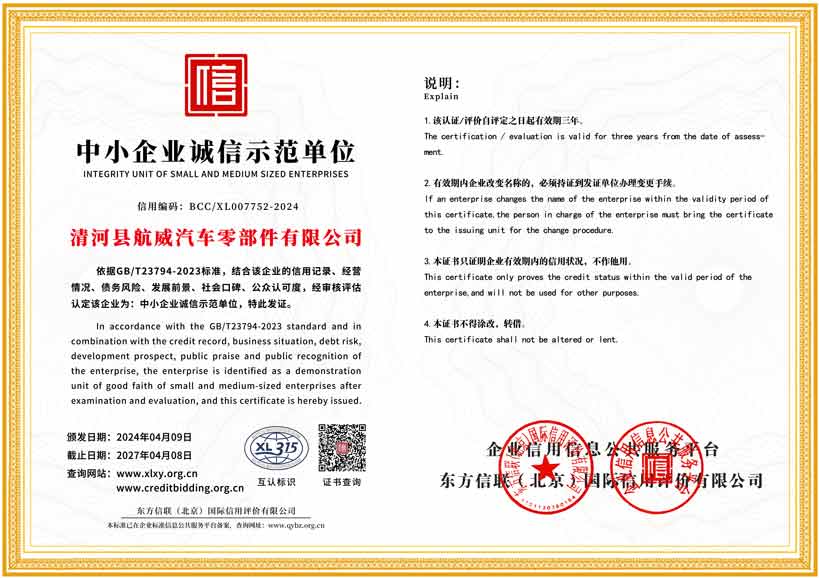carburetor accelerator cable
Understanding the Carburetor Accelerator Cable A Key Component in Automotive Performance
The carburetor accelerator cable plays a vital role in the functionality of a vehicle's engine, particularly in older cars that rely on carburetors for fuel-air mixture regulation rather than the more modern fuel injection systems. This seemingly simple component is crucial in determining how effectively the engine responds to the driver's input on the accelerator pedal. By understanding the workings, maintenance, and potential issues related to the carburetor accelerator cable, car enthusiasts and owners can ensure optimal performance of their vehicles.
Functionality of the Accelerator Cable
At its core, the carburetor accelerator cable connects the accelerator pedal to the carburetor. When a driver presses the accelerator pedal, the cable pulls on the carburetor’s throttle linkage, allowing more air and fuel to enter the engine, thus increasing its power output. The position of the throttle plate in the carburetor directly affects engine performance. Consequently, a well-functioning accelerator cable ensures a smooth and responsive acceleration, contributing to an enjoyable driving experience.
Common Issues
While the carburetor accelerator cable is designed to endure the rigors of automotive operation, it can experience wear and tear over time. Some common issues include fraying, kinking, or stretching of the cable. If the cable frays, it may not transmit the exact position of the accelerator pedal to the carburetor. This can result in inconsistent acceleration or difficulty in achieving the desired speed. Kinks can create resistance and hinder the smooth operation of the cable, while stretching can lead to a delay in throttle response.
Another issue may arise from binding due to improper installation or misalignment. If the cable is not correctly routed or if there are obstructions in its path, it can lead to sticky acceleration, causing the throttle to stick open or close inconsistently. This is not only detrimental to the performance of the vehicle but can also pose safety risks. Drivers encountering hesitation during acceleration or the throttle sticking should inspect the accelerator cable immediately.
carburetor accelerator cable

Maintenance and Inspection
Regular maintenance of the carburetor accelerator cable is essential for optimal vehicle performance. Routine inspections should be conducted to check for any signs of wear or damage. This includes looking for frayed sections, kinks, and ensuring that the cable moves freely without any obstruction. Applying a suitable lubricant to the cable can keep it functioning smoothly and reduce friction, which helps prevent premature wear.
Furthermore, it's essential to check the connection points of the cable at both the accelerator pedal and carburetor. Ensure that the cable is securely attached, as a loose connection can affect throttle response and overall engine performance. If any issues are identified during inspection, it is advisable to replace the cable promptly to avoid further complications.
Replacement Considerations
When it comes to replacing a faulty accelerator cable, owners should consider purchasing a high-quality component that matches the specifications of their vehicle. Aftermarket options are available, but it’s essential to ensure compatibility with the specific make and model of the car. Installation can be done as a DIY project for those with a basic understanding of automotive repairs, though seeking professional assistance is always recommended for those uncertain about the process.
Conclusion
The carburetor accelerator cable may be a small component in the grand scheme of automotive engineering, but its impact on vehicle performance is significant. By understanding its function, maintaining it properly, and addressing any issues promptly, drivers can enhance their vehicle's responsiveness and ensure a safe and enjoyable driving experience. Whether you're restoring a classic car or simply maintaining a vintage model, paying attention to the carburetor accelerator cable is an essential part of automotive care.
-
Workings of Clutch Pipe and Hose SystemsNewsJun.04,2025
-
The Inner Workings of Hand Brake Cable SystemsNewsJun.04,2025
-
The Secrets of Throttle and Accelerator CablesNewsJun.04,2025
-
The Hidden Lifeline of Your Transmission Gear Shift CablesNewsJun.04,2025
-
Demystifying Gear Cables and Shift LinkagesNewsJun.04,2025
-
Decoding Clutch Line Systems A Comprehensive GuideNewsJun.04,2025
